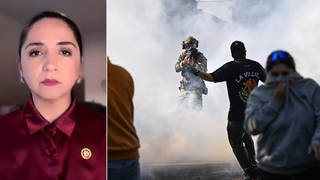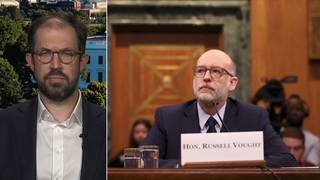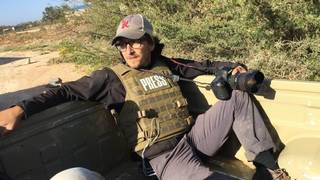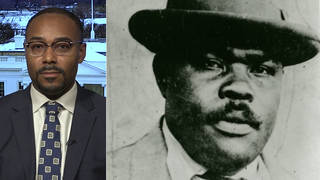
Guests
- Ed DuBosea member of the NAACP national board and former president of the Georgia branch of the NAACP. He has worked for years to bring those accountable in the Moore’s Ford lynching to justice.
- Herb BoydHarlem-based activist, teacher, author and journalist. He edits the online publication, The Black World Today, and writes for several publications, including Amsterdam News.
Federal authorities are reportedly investigating whether people who carried out one of the worst mass lynchings in recent history are still alive and can be brought to justice. It was July 25, 1946, when a white mob in rural Georgia ambushed a car carrying two African-American couples, dragged them out and shot them to death. One of the men, George Dorsey, was a military veteran who had recently returned from serving five years overseas in World War II. His wife, Mae Murray Dorsey, was also killed. Dorothy Malcom, the other woman in the car, was seven months pregnant. The mob cut her open and removed her unborn child. Her husband, Roger Malcom, had just been bailed out of jail after he was accused of stabbing a white man. A coroner estimated people in the crowd fired more than 60 shots at the two couples, at close range. The horrific attack was carried out near Walton County, Georgia, not far from Moore’s Ford Bridge. It became known as the Moore’s Ford lynching, and sparked a national outcry, prompting President Harry Truman to push for civil rights reform. The FBI also investigated, but no one was ever convicted of the four murders. But a relative of one of the men allegedly involved in the attack has come forward in a videotaped interview with the NAACP. Wayne Watson says his uncle and several other men he named were members of the Ku Klux Klan. We speak to Edward DuBose, a member of the NAACP national board and former president of the Georgia branch of the NAACP, and journalist Herb Boyd.
Transcript
JUAN GONZÁLEZ: A new report we covered here on Democracy Now! called “Lynching in America” has brought the legacy of racial terror back into the public conversation, and now federal authorities are reportedly investigating whether people who carried out one of the worst mass lynchings in recent history are still alive and can be brought to justice.
It was July 25th, 1946, when a white mob in rural Georgia ambushed a car carrying two African-American couples, dragged them out and shot them to death. One of the men, George Dorsey, was a military veteran who had recently returned from serving five years overseas in World War II. His wife, Mae Murray Dorsey, was also killed. Dorothy Malcom, the other woman in the car, was seven months pregnant. The mob cut her open and removed her unborn child. Her husband, Roger, had just been bailed out of jail after he was accused of stabbing a white man. A coroner estimated people in the crowd fired more than 60 shots at the two couples at close range. The horrific attack was carried out near Walton County, Georgia, not far from Moore’s Ford Bridge. It became known as the Moore’s Ford lynching and sparked a national outcry, even prompting President Harry Truman to push for civil rights reform. The FBI also investigated, but no one was ever convicted of the four murders.
AMY GOODMAN: Now that could all change. A relative of one of the men allegedly involved in the attack has come forward in a videotaped interview with the NAACP. Wayne Watson says his uncle and several other men he named were members of the Ku Klux Klan. This is a clip from his 2013 interview with then-president of the NAACP Ben Jealous.
WAYNE WATSON: And people tried to bribe me. I’ve been to prison, a detention center.
BEN JEALOUS: Why is—why does this case bother you so much? I mean, you’ve had a lot of people ask you to keep your mouth shut.
WAYNE WATSON: Yeah.
BEN JEALOUS: Why do you stay interested in it?
WAYNE WATSON: Why?
BEN JEALOUS: Yeah.
WAYNE WATSON: Because I’m tired of it. I’m tired of—when you go through life, you’re living with lies, or you’re living with people talking about things. I want it all over with. The racism, I mean, I’ve been on the street, and, you know, I told people I’ve dated a black woman [inaudible], and you can’t get nothing. A white man goes around here and says he’s dating a black woman or hanging around black people, you can’t get no loan, you can’t go to no bank, borrow money or nothing. They turn you down.
AMY GOODMAN: This week, The Guardian newspaper reported that after Wayne Watson’s interview, the FBI spoke with one of the men he identified—his uncle, his father’s brother, a man named Charlie Peppers, who’s now 86 years old. Peppers said two FBI agents visited him last year and questioned him for about 40 minutes. The FBI has not confirmed the report but says the probe into the attack remains an active investigation.
Well, for more, we’re joined by Edward DuBose, a member of the NAACP national board and former president of the Georgia branch of the NAACP. He’s a longtime participant in an effort to bring those accountable for the Moore’s Ford lynching to justice. We are also joined by Herb Boyd, Harlem-based activist, teacher, author and journalist. He worked on a documentary about the lynching with the filmmaker Keith Beauchamp.
We welcome you both to Democracy Now! Ed DuBose, tell us what happened that day, as you understand it.
EDWARD DUBOSE: First of all, good morning, and thank you for having me on the show. You know, we have long talked about this case. We know that. How this case came about, to give you a little background, Mr. Malcom, allegedly—and we know that to be the case—stabbed a gentleman, Mr. Hester, but it was rumored that he had been sleeping with Mr. Malcom’s wife. And so, we know that after this incident, Mr. Malcom was arrested. Not even three weeks later, he was—bail was posted for him. And this gentleman, his wife, Mr. Dorsey and his wife were all taken to this Moore’s Ford Bridge, where they were brutally lynched and, as you all stated in the beginning of the show, shot over 60 times.
We know that there was a grand jury that was impaneled. Over 50 suspects were of interest, were interviewed. But no one—no one was ever accused. No one was ever arrested. And so we have this mass public lynching, one of the last mass public lynchings, one of the most egregious acts, and included in this is a World War II veteran. No one has ever been brought to justice in this case. And so, we’re so glad that you all and other media outlets are taking a look at this case, as we continue to push for justice.
JUAN GONZÁLEZ: Now, there was a—wasn’t there an Associated Press report of several years ago that claimed that there was some indication that the governor at the time, Eugene Talmadge, had actually visited that particular town, spoken to the—spoken to the brother of the man who had been stabbed, and basically said, “Anybody who takes care of the African American who was involved in this, they don’t have to worry.” Is that—
EDWARD DUBOSE: That’s absolutely correct. And remember, during that time, Governor Talmadge ran on the platform, “Segregation now, segregation forever,” you know, and so he was politically motivated and, many would say, empowered the people in his community to let them know it’s OK, you know, African-American—black life don’t matter. And so, you’re absolutely correct. Governor Talmadge, in his own right, sent a message to this county and to the state.
AMY GOODMAN: So, talk about Wayne Watson naming names, and just who Wayne Watson is.
EDWARD DUBOSE: Wayne Watson is a gentleman from Monroe, Georgia, Walton County, who had been sought out by one of our people in the county. People had always said that there was no one alive, there was no one available, that would be able to shed light on this case. Well, we’re so glad that Mr. Watson was found. And we were able to bring our then-president, Ben Jealous, to interview with Mr. Watson. His interview was so compelling that initially we were just talking to him, but he began to name names and locations and people and places. And our president, Jealous, said, “Wait a minute, we need to get this on tape. This guy is talking about very compelling information that the FBI need to be aware of.”
AMY GOODMAN: So let’s go back to that interview that the former president of the NAACP, Ben Jealous, did with Wayne Watson, who says he previously reported his allegations to local law enforcement officials.
WAYNE WATSON: Alan Cook, the DA, was trying to find out who knew about it and everything like that. And evidently, my attorney told somebody or told him. Come next thing I know, everybody in Walton County knew I was the one that knew about the KKK, who was alive. And people tried to bribe me. I’ve been to prison, a detention center, and they offered me money. Robert Mitchell offered me $250,000 to keep my mouth shut, walk away in '99. I told him I wouldn't do it. He said, “You’ll be dead before you ever testify.”
AMY GOODMAN: That, again, another part of that Wayne Watson interview with Ben Jealous. Ed DuBose, if you could comment on that, and also, how was Dr. King involved? I mean, this lynching was 1946.
EDWARD DUBOSE: Yeah, and again, first off, let me thank also State Representative Tyrone Brooks. I don’t want to be on the show without giving him the credit due for convening us in this case. So, Dr. King had been informed about this case. Dr. King had made a commitment that after he left Memphis, that he would be visiting Walton County. And so Dr. King never made it. You’ll recall that Dr. King was assassinated. But Dr. King was always interested in this case and coming to Walton County to speak out on this injustice.
JUAN GONZÁLEZ: And, Herb Boyd, talk about the significance of this case and why you got involved in a documentary on it.
HERB BOYD: Well, it was certainly Keith Beauchamp’s idea. You know, he had put together The Untold Story of Emmett Till, and it has pushed him more and more into the history of lynching. It’s good to see that Bryan Stevenson, you know, has brought out that study and connecting up, in terms of contextualizing 1946. Here’s a returning veteran, gone off, you know, fought for this country, to come home, virtually still in uniform, you know, when he’s abducted, along with his wife, along with Roger Malcom and Dorothy. She’s seven months pregnant. So when we heard about that, Keith said, “Let’s do this one.” And the most powerful thing about his documentary is the re-enactment that we do on that particular incident.
AMY GOODMAN: And what did you discover at that time, in terms of what has been investigated?
HERB BOYD: Well, you know, we were looking at how the FBI would be involved in this situation, because they had given the other cases we had worked on, had given us every indication that they were going to seriously pursue this situation. Tyrone Brooks was very, very instrumental in helping us understanding the background on the situation. But I don’t know. You know, it just kind of stalled at that point. We went on to other projects, and only recently, with it popping up in the news again, we have to go back and revisit and take a look again at the kind of research we did on that situation.
AMY GOODMAN: Ed DuBose, at this point, what are you calling for now?
EDWARD DUBOSE: Well we’ve endorsed a letter, last year and even this year, to the Senate Judiciary Committee. We want the Congress and the Senate, the U.S. Congress and Senate, to take a look at this case, calls for an investigation of this case, because keep in mind, in 2008, then Congressman John Lewis and Senator Christopher Dodd sponsored the Emmett Till bill, which allocated resources for cold cases. It has never been fully funded. And so, one, we want it to be fully funded to give the resources to the Federal Bureau of Investigation that they need. If that’s the hold-up, give them the money that they need, that has already been voted on. And President Obama can—he can do that. And so, we hope that people who are watching will join us in reaching out to your Congress or Senate and tell them to communicate with Mr. Grassley, Chairman Grassley, to allow this case to be investigated and those responsible brought to justice. If we can take—if we could find Nazis in the United States who have committed atrocities, certainly we can find people in Walton County, Georgia.
JUAN GONZÁLEZ: And there’s an indication that there are still several people who may have participated in it that are alive?
EDWARD DUBOSE: We are convinced that, and we believe that the FBI is convinced—we hope that they move—that there are people still alive who were involved in this case. There were over 200 people on that bridge. You couldn’t tell me that all of them are dead now.
AMY GOODMAN: Charlie Peppers?
EDWARD DUBOSE: Charlie Peppers, I believe, knows more than what Charlie Peppers is saying. And I hope they continue to interview him.
AMY GOODMAN: We were just showing the re-enactment from the film that Herb Boyd worked on with Keith Beauchamp of the 1946 lynching. We thank you both for being with us. Ed DuBose is member of the NAACP national board and former president of the Georgia branch of the NAACP, has worked for years on the case, bringing—wanting to try to bring those accountable in the Moore’s Ford lynching to justice. And, Herb Boyd, we ask you to stay with us—
HERB BOYD: Sure.
AMY GOODMAN: —because next up we’re talking about Malcolm X on this, the 50th anniversary of his assassination. This is Democracy Now!, democracynow.org, The War and Peace Report. Back in a minute.












Media Options